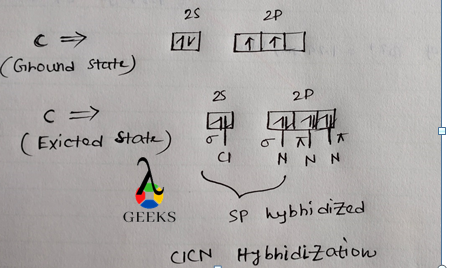In this article we are going to discuss about clcn lewis structure, characteristics and 13 essential facts regarding cyanogen chloride.
Clcn is a colorless easily condensed toxic gas. It has acrid odor. It belongs to the category of pseudohalogen. It is produced when sodium cyanide is oxidized with chlorine gas. The reaction involves an intermediate which is cyanogen. In presence of acid it trimerizes to produce cyanuric chloride.
Clcn Lewis Structure Drawing
In the lewis structure of Clcn, central C atom uses sp hybrid orbital to form Clcn compound. When C atom is exicted, there occurs 4 valance electron. Out of these 4 electrons, 1 is used in making sigma bond with Cl atom. Hence 1 electron of Cl atom is take part in bonding with central C atom, remaining 6 electron exist as 3 lone pair of electron.
Remaining 3 velence electrons of C atom form 1 sigma and 2 pi bonds with N atom. Hence no lone pair exist on C atom. N has 5 valance electrons, only 2 is remain unused, this exist as 1 lone pair of electron. But 3 electrons take part in bonding with central C atom.

Clcn Lewis Structure Resonance
Resonance or mesmerism is a process of describing movement of nonbonding and pi electrons between atoms in various types of polyatomic molecules through delocalization and resonance hybrid is a combination all the resonation structure. In Clcn 2 equivalent resonating structure are found. In these structures C-Cl bond acquires partial double bond character.
The fact behind this anomalous characteristics is that filled 2p electron i.e. nonbonding electron pair on Cl atom is delocalized with the vacant ∏* antibonding molecular orbital of –CN group and partial double bond character is developed between C and Cl atom. By this resonance process triple bond between C and N atom is reduced to double bond.

Clcn Lewis Structure Shape
According to VSEPR theory the shape of Clcn is linear in which central carbon atom is attached with Cl atom by single bond and with N atom by triple bond. Each atom in Clcn is lie in a line. The linear shape of Clcn occurs because of the fact that central C atom is sp hybridized. As Clcn has linear shape so that the bond angle found in Clcn is 1800.
Clcn Lewis Structure Formal Charge
In Clcn, the formal charge on the given atoms is calculated by the following formula given below:
Formal Charge (F.C) on any atom= valance electrons of the atom-(total bonding electrons)/2- No of nonbonding electron pair.
Hence formal charge on central C atom in Clcn =4-8/2-0= 0.
Formal charge on N atom of –CN group in Clcn =5-6/2-2=0.
Formal charge on Cl atom in Clcn compound =7-2/2-6=0.
Hence formal charge on central C atom in Clcn is equal to 0. All of the atoms in Clcn has zero formal charge making the whole compound is electrically neutral.
Clcn Lewis Structure Angle
In Clcn , central carbon atom uses sp hybrid orbital to form bonds with chloride group and N atom i.e. the angle between Cl-C-N is 1800. The N atom in –CN group is also sp hybridized.
When Cl atom is in conjugation with –CN group, Cl atom becomes sp2 hybridized. As central C atom in Clcn is sp hybridized and the angle is 1800, the compound Clcn is linear in nature.

Clcn Lewis structure Octet Rule
In the clcn lewis structure, all the atoms i.e. Cl, C, N fulfilled their octet. The central C atom in Clcn forms 1 sigma bond with Cl atom and another with N atom. At the same time it forms 2 pi bonds with N atom by overlap of 2 p orbitals of C and N atom. Hence central C atom forms 4 bonds which contains total of 8 electrons.
Cl atom forms 1 single bond with central C atom and contains 3 lone pair of electron i.e. a total of 8 electrons present in Cl. The N atom forms 1 sigma and 2 pi bonds with central C atom and also contain 1 lone pair i.e. again total 8 electrons present in N. According to octet rule Clcn is a stable compound.
Clcn Lewis Structure Lone Pairs
The lone pair of electrons is those valance electrons which are not shared when 2 atoms are connected by a covalent bond. It is also defined as unshared pair of electrons.
The formula through which we can calculate the lone pair of electron on the given atoms in Clcn is given below:
Lone electron pairs present on an atom= electrons which is present on the valance shell of the atom – how many chemical bonds formed by that particular atom.
Lone pair of electron present on central C atom in Clcn= 4-4=0 i.e. 0 lone pair of electron.
Lone electron pair present on N atom of –CN group in Clcn=5-3=2 i.e. 1 unshared electron pair.
Lone pair of electrons present on Cl atom in Clcn compound= 7-1=6 i.e.3 nonbonding pairs of electron.
These nonbonding electron pairs are depicted in the lewis structure of Clcn on C, N, Cl atoms as electron dots.
Clcn Valance Electrons
As to find out total no of valance electron in Clcn it is essential to know how many valance electrons present in C, N and cl atoms. In C the total valance electron present is 4 (2s2 2p2). Nitrogen atom has ground state electronic configuration of 1s2 2s2 2p3 hence, total 5 valance electrons present in N atom and from electronic configuration of Cl atom we see that there exist 7 valance electrons.
Thus the total valance electron of Clcn is equal to sum of valance electron of C, Cl, N atoms.
The total valance electron present in Clcn is (4*1)+(1*5)+(7*1)=16.
Clcn Hybridization
We know that pure atomic orbitals don’t participate in bonding because they have different energies. For this reason atomic orbitals of different energy mixes to form hybrid orbitals of similar energy. This process is denied as hybridization.
C atom has the electronic configuration of 2s2 2p2 in ground energy and we see that there only 2 unpaired electrons present in the valance shell of C atom and to produce Clcn, 4 unpaired electrons required. When some energy is applied, 1 2s electrons enters into empty 2p orbital creating a total of 4 unpaired electrons in the valance shell of C atom.
In the next step, 1 Cl atom give its 1 unpaired electron to form C-Cl bond. At first N atom forms 1 sigma bond with central C atom by using its 1 unpaired electron, then the remaining 2 unpaired electrons of 2p orbital of N atom forms pi bonds with central C atom. As central C atom forms 2 sigma and 2 pi bonds, it is sp hybridized.

Clcn solubility
Clcn is polar compound. As it is polar in anture, it is soluble in polar solvent e.g. water, methanol, ethanol etc. When it reacts with water, it is undergoes slow hydrolysis to form cyanate (NCO-) and chloride ions (cl-) and H+ ion is also produced. This reaction happens in neutral pH medium.

Is Clcn Ionic?
Clcn is an ionic compound. This is due to the fact that It disintrigates into ions when it is in molten state or in aqueous state. When Clcn is added in water medium, isocyante, chloride and H+ ions are formed. As it forms ions in aqueous solution, it is an ionic compound.
The aqueous solution of Clcn also conducts electricity, like other ionic compound does when they dissolve in aqueous solution.
Is Clcn acidic or basic?
Clcn is basic in nature. It is a bronsted as well as lewis base. When it reacts with lewis acid it donates its lone pair of electron through N atom and forms coordination compound.
When it reacts with acid which gives H+ ions, it accept H+ ions by donating its lone pair of electron through N atom. Lone pair donation occurs through N atom because N is less electronegative than Cl atom i.e. +ve charge favorable on N atom that Cl atom.
Is Clcn polar or nonpolar?
Clcn is polar in nature. A compound is found to be polar if all the bond moments in the compound are not cancelled out. In this compound due to presence of sp hybridized –CN group, C-Cl bond moment lies towards –CN group.
In Clcn compound, lone pair on Cl atom is delocalized with the empty ∏* antibonding orbital of -CN group and for this reason, –ve pole creates on N atom and +ve pole creates on chlorine atom. Hence there occurs larger distribution of charge. That is why Clcn in polar in nature and its dipole moment not equal to zero.
Is Clcn linear or Tetrahedral?
Clcn has linear shape with sp hybridization of the central C atom. So, probability of tetrahedral shape does not arise.
Conclusion
By the above facts we discussed it is concluded that Clcn is a polar, ionic, covalent compound in which central C atom uses sp hybrid orbital. It is miscible with water because it is a polar compound. It is a stable compound according to octet as well as resonance.
Also Read:
- Mgh2 lewis structure
- Nof lewis structure
- Agno3 lewis structure
- Ch2cl2 lewis structure
- Ibr3 lewis structure
- Ba3n2 lewis structure
- Ch3o lewis structure
- Bi3 lewis structure
- N2h4 lewis structure
- Nh2cooh lewis structure

Hi….I am Susanta Maity. I have completed my Masters from Vidyasagar university with a specialization in organic chemistry.
I love to write complicated Chemistry concepts in understandable and simple words.
Let’s connect through LinkedIn: